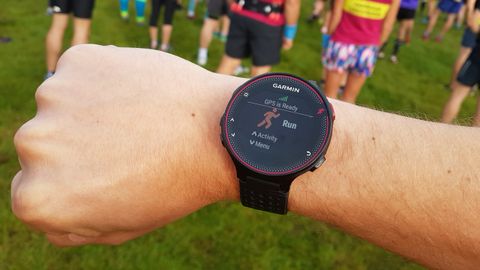Why you can trust TechRadar
Heart rate
- Useful 24/7 heart rate tracking
- Suspect VO2 Max scores
The Garmin Forerunner 235 tracks heart rate (HR) from the wrist, though you can also pair ANT+ chest straps if you prefer the accuracy this brings.
It was one of the earlier devices to eschew the Mio optical heart rate sensors in favor of Garmin Elevate sensor technology.
We put the 235 to the test up against the Polar M430 over a range of sessions, including a marathon distance.
As you can see from the graph, the devices performed fairly consistently. Garmin (bottom graph) clocked the average HR at 154bpm and Max HR at 179bpm while the Polar M430 registered a 154bpm average but a Max HR of 172bpm. Anecdotally during the run the Polar seemed to run at 3-4bpm lower than the Garmin.
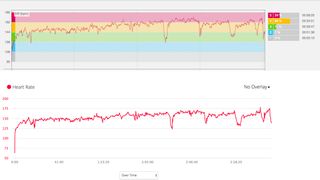
Both devices offer resting heart rate (RHR) tracking and when we came to compare them, both gave identical readings but the way Garmin highlights this hugely useful benchmark for health and fitness is much better.
In fact, the continuous 24/7 heart rate tracking on the Forerunner 235 is one of the best we’ve seen for monitoring your progress and spotting things like potential over-training and incoming colds.
With the touch of a button you get a read out of your current heart rate, highs and lows, your average RHR and a visual showing the last 4 hours. You can then tap for a chart of your RHR over the last 7 days.
Resting heart rate high that morning? That’s a sign you might want to skip a training session or ease off the intensity, and the Forerunner 235 makes that a much easier decision.

The Forerunner 235’s optical heart rate sensor also powers a VO2 Max reading, or the maximum volume of oxygen you can use, measured in milliliters per kilogram of body weight per minute (ml/kg/min). It’s another great indicator of your current fitness levels and progress.
Usually done in a lab test, watches, such as the Forerunner 235, increasingly boast estimated VO2 Max scores. Without stepping into a lab it’s hard to assess the accuracy but when we compared the Polar M430’s score with the Forerunner 235, it’s clear that someone’s got it wrong.
Polar estimated our VO2 Max at 69, just one point shy of what Runner’s World could classify as an elite result. Garmin, in contrast, has us at 51 which is somewhere between sedentary 35-year-old and average 35-year-old. That’s a stark contrast and the truth is we’re probably somewhere in between.
Many running watches we've tested haven't been on the money with this metric, but as long as it's consistent you can use it as a sign that you're getting fitter - which is far more important to many.
Run tracking and running metrics
- GPS locks on quickly
- Accuracy seems reasonable but not perfect
There are four sport modes: Run, Run Indoor, Cycle and Other, and it’s really useful that you can customize two data screens with up to four fields to create your own preferred displays for each of these.
Indoor runs are tracked by the on-board accelerometer while GLONASS and GPS provide the usual outdoor pace, distance and speed metrics. In our treadmill test the Garmin was within 5% on total distance, though unsurprisingly the pacing rarely matched the treadmill’s.
Outdoors we consistently got a rapid GPS fix, though when it came to accuracy there were some question marks. For example, on our marathon test, running an officially measured course, the Forerunner 235 clocked our distance at 41.96km, short of the 42.195km.
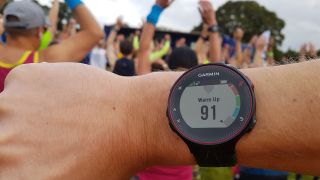
That’s not far out but in our experience running watches tend to come up longer rather than shorter over a marathon once they’ve taken a bit of weaving into account.
In addition to distance, time, pace and calories, during your run you can also see cadence, heart rate and heart rate zone and there are customizable audio and vibrating alerts to help guide you on target pace and heart rate.
You can store up to 200 hours of activity on the watch itself giving you plenty of scope should you wish to dig for insights from your past runs from the wrist, though with instant updates via your smartphone’s Bluetooth to Garmin Connect you might not need that.
Activity

- Tracks your steps and distance all day
- Shows how active you've been at a glance
The Forerunner 235 isn’t just a running watch, it’s also a comprehensive activity tracker that learns your daily patterns and automatically sets you step goals to strive for.
The main screen features an inactivity bar that creeps around the watch face when you’re on your backside, plus the accelerometer will keep tabs on your overall step count and distance covered during the day.
All of which you can access with two taps of the left-hand arrow button to take you to a display.
If you're into that sort of thing, it's a great extra feature to have, and you can even join leaderboards of other Garmin users to try and out-step them in a single day.
Warning: this can become addictive.
Smart training, recovery and sleep
- Race Predictor seems unreliable
- Sleep tracking skills are lacking
Tracking what you do when you’re training is one thing but there’s more to improving performance than just run session stats.
Being able to see the impact of your training run, predict recovery time and do things to recover quicker are all really useful and the Forerunner 235 offers a good set of features for just this.
Post run you get what Garmin calls Training Effort, a heart rate-based assessment of the overall training impact of your run. Scored on a scale from 0-5 it’s designed to tell you whether your session had an improving effect on your fitness.
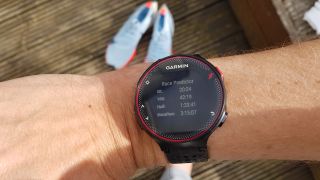
Then there’s the Recovery Advisor that tells you how long it’ll take to recover from your most recent effort. There’s a Race Predictor feature too that uses all of your data to estimate how quickly you could run a 5k, 10k, half and full marathon.
However, in practice we question how reliable this is as a true guide. Having just struggled to run a marathon in 3:59, it feels unlikely that the predicted time of 3:15 is accurate. Conversely, we’re pretty sure we can run 5km quicker than the 20.24 estimate.
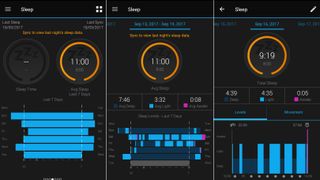
Sleep also features, with the Forerunner 235 offering some assessment of the quality of your pillow time. However, when we tested it against the Polar M430 there were quite significant discrepancies.
Garmin had us asleep at 9:38pm (we were on the sofa but not asleep) while Polar correctly recognized we actually fell asleep an hour later. Overall -
according to Garmin - we had nearly 12 hours of sleep compared to Polar’s 8 hours 46 minutes.
In general, Garmin’s sleep tracking has a way to go before it matches up to Polar, which offers up things like sleep efficiency totals, accurately captured sleep interruptions and is starting to turn sleep tracking into a genuinely useful training insight.
Current page: Specs, performance and fitness
Prev Page Introduction and design Next Page App, battery life and verdict